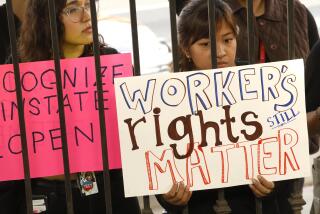Report: Arts nonprofits fuel economy
- Share via
Nonprofit arts groups, including museums, orchestras, theaters and dance companies, contributed $166.2 billion and 5.7 million jobs to the U.S. economy in 2005, according to an advocacy group urging more funding for the arts.
The numbers undercut a common belief that spending on arts and culture comes at the expense of economic development, said Randy Cohen, vice president of policy and research at Americans for the Arts, which released the report Tuesday.
“Support for the arts isn’t a black hole,” Cohen said. “Arts organizations are businesses. They pay people. They purchase supplies and services. They pay utility bills. That spending supports jobs and generates government revenue.”
The economic effect of these nonprofits grew by 24%, or 11% adjusted for inflation, between 2000 and 2005, according to the report.
In 2000, nonprofit arts groups generated $134 billion in economic activity and 4.9 million jobs, the group said.
The calculations include artists’ salaries, the money that arts groups spend on services and supplies, and audience spending on hotels, meals and parking. Also included is money “re-spent” on salaries and goods within the local community -- for example, groceries purchased by an employee of the printing firm that publishes an arts group’s programs.
Washington-based Americans for the Arts will use the study to argue for greater funding of the arts by government, individuals, companies and foundations.
The group is pressing Congress for an almost 40% boost in funding to the National Endowment for the Arts to reverse a cut made by Republicans after they took over in 1995. Last month, the group released a report saying arts organizations are “at risk” due to a drop in corporate giving and lack of growth in giving by foundations and individuals.
Defending arts on economic terms is not a universally accepted approach. The Wallace Foundation, which aims to expand the demand and appreciation for the arts, commissioned a 2004 Rand Corp. study that questioned the strategy. It found most research efforts to tie arts to economic growth fail to prove cause-and-effect and obscure more basic reasons to support arts.
Tuesday’s study was based on information collected from 6,080 nonprofit organizations and 94,478 of their attendees in 156 U.S. communities and regions. There are 100,000 nonprofit arts and culture organizations in U.S., according to Americans for the Arts.
New York City and Los Angeles, each with more than $1 billion in spending by arts organizations, were excluded to avoid inflating the national numbers.
The study was funded by the Paul G. Allen Family Foundation, the John D. and Catherine T. MacArthur Foundation and the Ruth Lilly Fund of Americans for the Arts.
More to Read
The biggest entertainment stories
Get our big stories about Hollywood, film, television, music, arts, culture and more right in your inbox as soon as they publish.
You may occasionally receive promotional content from the Los Angeles Times.










